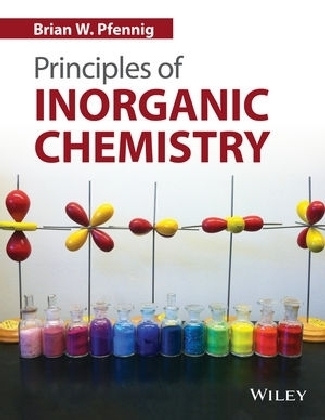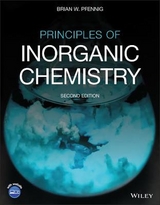
Principles of Inorganic Chemistry
John Wiley & Sons Inc (Verlag)
978-1-118-85910-0 (ISBN)
- Titel erscheint in neuer Auflage
- Artikel merken
* Takes a principles-based, group and molecular orbital theory approach to inorganic chemistry * The first inorganic chemistry textbook to provide a thorough treatment of group theory, a topic usually relegated to only one or two chapters of texts, giving it only a cursory overview * Covers atomic and molecular term symbols, symmetry coordinates in vibrational spectroscopy using the projection operator method, polyatomic MO theory, band theory, and Tanabe-Sugano diagrams * Includes a heavy dose of group theory in the primary inorganic textbook, most of the pedagogical benefits of integration and reinforcement of this material in the treatment of other topics, such as frontier MO acid--base theory, band theory of solids, inorganic photochemistry, the Jahn-Teller effect, and Wade's rules are fully realized * Very physical in nature compare to other textbooks in the field, taking the time to go through mathematical derivations and to compare and contrast different theories of bonding in order to allow for a more rigorous treatment of their application to molecular structure, bonding, and spectroscopy * Informal and engaging writing style; worked examples throughout the text; unanswered problems in every chapter; contains a generous use of informative, colorful illustrations
Brian W. Pfennig, PhD, received his undergraduate B.S. degree in chemistry at Albright College in 1988. He earned his Ph.D. in 1992 in the field of physical inorganic chemistry at Princeton University with Dr. Andrew B. Bocarsly, studying the photochemistry of organometallic sandwich compounds and electron transfer in multinuclear mixed-valence coordination compounds. Dr. Pfennig has held a number of different teaching appointments at small liberal arts colleges, including Franklin & Marshall College, Haverford College, Vassar College, and Ursinus College. During his 20-year teaching career, he has taught general chemistry, an accelerated one-semester general chemistry course, both introductory and advanced inorganic chemistry, bio-inorganic chemistry, and inorganic and organometallic photochemistry, as well as serving as the general chemistry laboratory coordinator at Ursinus College for the past 10 years. He is also actively engaged in research with undergraduates in the areas of inorganic photochemistry, electrochemistry, and electron transfer processes occurring in multinuclear mixed-valence coordination compounds. He has also published several papers in the area of chemical education.
Preface xi Acknowledgements xv Chapter 1 The Composition of Matter 1 1.1 Early Descriptions of Matter 1 1.2 Visualizing Atoms 6 1.3 The Periodic Table 8 1.4 The Standard Model 9 Exercises 12 Bibliography 13 Chapter 2 The Structure of the Nucleus 15 2.1 The Nucleus 15 2.2 Nuclear Binding Energies 16 2.3 Nuclear Reactions: Fusion and Fission 17 2.4 Radioactive Decay and The Band of Stability 22 2.5 The Shell Model of the Nucleus 27 2.6 The Origin of the Elements 30 Exercises 38 Bibliography 39 Chapter 3 A Brief Review of Quantum Theory 41 3.1 TheWavelike Properties of Light 41 3.2 Problems with the Classical Model of the Atom 48 3.3 The Bohr Model of The Atom 55 3.4 Implications of Wave-Particle Duality 58 3.5 Postulates of Quantum Mechanics 64 3.6 The Schrodinger Equation 67 3.7 The Particle in a Box Problem 70 3.8 The Harmonic Oscillator Problem 75 Exercises 78 Bibliography 79 Chapter 4 Atomic Structure 81 4.1 The Hydrogen Atom 81 4.1.1 The Radial Wave Functions 82 4.1.2 The Angular Wave Functions 86 4.2 Polyelectronic Atoms 91 4.3 Electron Spin and the Pauli Principle 93 4.4 Electron Configurations and the Periodic Table 96 4.5 Atomic Term Symbols 98 4.5.1 Extracting Term Symbols Using Russell Saunders Coupling 100 4.5.2 Extracting Term Symbols Using jj Coupling 102 4.5.3 Correlation between RS (LS) Coupling and jj Coupling 104 4.6 Shielding and Effective Nuclear Charge 105 Exercises 107 Bibliography 108 Chapter 5 Periodic Properties of the Elements 109 5.1 The Modern Periodic Table 109 5.2 Radius 111 5.3 Ionization Energy 118 5.4 Electron Affinity 121 5.5 The Uniqueness Principle 122 5.6 Diagonal Properties 124 5.7 The Metal Nonmetal Line 125 5.8 Standard Reduction Potentials 126 5.9 The Inert-Pair Effect 129 5.10 Relativistic Effects 130 5.11 Electronegativity 133 Exercises 136 Bibliography 137 Chapter 6 An Introduction to Chemical Bonding 139 6.1 The Bonding in Molecular Hydrogen 139 6.2 Lewis Structures 140 6.3 Covalent Bond Lengths and Bond Dissociation Energies 144 6.4 Resonance 146 6.5 Polar Covalent Bonding 149 Exercises 153 Bibliography 154 Chapter 7 Molecular Geometry 155 7.1 The VSEPR Model 155 7.2 The Ligand Close-Packing Model 170 7.3 A Comparison of The VSEPR and LCP Models 175 Exercises 176 Bibliography 177 Chapter 8 Molecular Symmetry 179 8.1 Symmetry Elements and Symmetry Operations 179 8.1.1 Identity, E 180 8.1.2 Proper Rotation, Cn 181 8.1.3 Reflection, 182 8.1.4 Inversion, i 183 8.1.5 Improper Rotation, Sn 183 8.2 Symmetry Groups 186 8.3 Molecular Point Groups 191 8.4 Representations 195 8.5 Character Tables 202 8.6 Direct Products 209 8.7 Reducible Representations 214 Exercises 222 Bibliography 224 Chapter 9 Vibrational Spectroscopy 227 9.1 Overview of Vibrational Spectroscopy 227 9.2 Selection Rules for IR and Raman-Active Vibrational Modes 231 9.3 Determining The Symmetries of The Normal Modes of Vibration 235 9.4 Generating Symmetry Coordinates Using The Projection Operator Method 243 9.5 Resonance Raman Spectroscopy 252 Exercises 256 Bibliography 258 Chapter 10 Covalent Bonding 259 10.1 Valence Bond Theory 259 10.2 Molecular Orbital Theory: Diatomics 278 10.3 Molecular Orbital Theory: Polyatomics 292 10.4 Molecular Orbital Theory: pi Orbitals 305 10.5 Molecular Orbital Theory: More Complex Examples 317 10.6 Borane and Carborane Cluster Compounds 325 Exercises 334 Bibliography 336 Chapter 11 Metallic Bonding 339 11.1 Crystalline Lattices 339 11.2 X-Ray Diffraction 345 11.3 Closest-Packed Structures 350 11.4 The Free Electron Model of Metallic Bonding 355 11.5 Band Theory of Solids 360 11.6 Conductivity in Solids 374 11.7 Connections Between Solids and Discrete Molecules 383 Exercises 384 Bibliography 388 Chapter 12 Ionic Bonding 391 12.1 Common Types of Ionic Solids 391 12.2 Lattice Enthalpies and The Born Haber Cycle 398 12.3 Ionic Radii and Pauling s Rules 404 12.4 The Silicates 417 12.5 Zeolites 422 12.6 Defects in Crystals 423 Exercises 426 Bibliography 428 Chapter 13 Structure and Bonding 431 13.1 A Reexamination of Crystalline Solids 431 13.2 Intermediate Types of Bonding in Solids 434 13.3 Quantum Theory of Atoms in Molecules (QTAIM) 443 Exercises 449 Bibliography 452 Chapter 14 Structure and Reactivity 453 14.1 An Overview of Chemical Reactivity 453 14.2 Acid Base Reactions 455 14.3 Frontier Molecular Orbital Theory 467 14.4 Oxidation Reduction Reactions 473 14.5 A Generalized View of Molecular Reactivity 475 Exercises 480 Bibliography 481 Chapter 15 An Introduction to Coordination Compounds 483 15.1 A Historical Overview of Coordination Chemistry 483 15.2 Types of Ligands and Nomenclature 487 15.3 Stability Constants 490 15.4 Coordination Numbers and Geometries 492 15.5 Isomerism 498 15.6 The Magnetic Properties of Coordination Compounds 501 Exercises 506 Bibliography 508 Chapter 16 Structure, Bonding, and Spectroscopy of Coordination Compounds 509 16.1 Valence Bond Model 509 16.2 Crystal Field Theory 512 16.3 Ligand Field Theory 525 16.4 The Angular Overlap Method 534 16.5 Molecular Term Symbols 541 16.5.1 Scenario 1 All the Orbitals Are Completely Occupied 546 16.5.2 Scenario 2 There Is a Single Unpaired Electron in One of the Orbitals 546 16.5.3 Scenario 3 There Are Two Unpaired Electrons in Two Different Orbitals 546 16.5.4 Scenario 4 A Degenerate Orbital Is Lacking a Single Electron 547 16.5.5 Scenario 5 There Are Two Electrons in a Degenerate Orbital 547 16.5.6 Scenario 6 There Are Three Electrons in a Triply Degenerate Orbital 547 16.6 Tanabe Sugano Diagrams 549 16.7 Electronic Spectroscopy of Coordination Compounds 554 16.8 The Jahn Teller Effect 564 Exercises 566 Bibliography 570 Chapter 17 Reactions of Coordination Compounds 573 17.1 Kinetics Overview 573 17.2 Octahedral Substitution Reactions 577 17.2.1 Associative (A) Mechanism 578 17.2.2 Interchange (I) Mechanism 579 17.2.3 Dissociative (D) Mechanism 580 17.3 Square Planar Substitution Reactions 585 17.4 Electron Transfer Reactions 593 17.5 Inorganic Photochemistry 606 17.5.1 Photochemistry of Chromium(III) Ammine Compounds 607 17.5.2 Light-Induced Excited State Spin Trapping in Iron(II) Compounds 611 17.5.3 MLCT Photochemistry in Pentaammineruthenium(II) Compounds 615 17.5.4 Photochemistry and Photophysics of Ruthenium(II) Polypyridyl Compounds 617 Exercises 622 Bibliography 624 Chapter 18 Structure and Bonding in Organometallic Compounds 627 18.1 Introduction to Organometallic Chemistry 627 18.2 Electron Counting and the 18-Electron Rule 628 18.3 Carbonyl Ligands 631 18.4 Nitrosyl Ligands 635 18.5 Hydride and Dihydrogen Ligands 638 18.6 Phosphine Ligands 640 18.7 Ethylene and Related Ligands 641 18.8 Cyclopentadiene and Related Ligands 645 18.9 Carbenes, Carbynes, and Carbidos 648 Exercises 651 Bibliography 654 Chapter 19 Reactions of Organometallic Compounds 655 19.1 Some General Principles 655 19.2 Organometallic Reactions Involving Changes at the Metal 656 19.2.1 Ligand Substitution Reactions 656 19.2.2 Oxidative Addition and Reductive Elimination 658 19.3 Organometallic Reactions Involving Changes at the Ligand 664 19.3.1 Insertion and Elimination Reactions 664 19.3.2 Nucleophilic Attack on the Ligands 667 19.3.3 Electrophilic Attack on the Ligands 669 19.4 Metathesis Reactions 670 19.4.1 -Bond Metathesis 670 19.4.2 Ziegler Natta Polymerization of Alkenes 671 19.4.3 -Bond Metathesis 671 19.5 Commercial Catalytic Processes 674 19.5.1 Catalytic Hydrogenation 674 19.5.2 Hydroformylation 674 19.5.3 Wacker Smidt Process 676 19.5.4 Monsanto Acetic Acid Process 677 19.6 Organometallic Photochemistry 678 19.6.1 Photosubstitution of CO 678 19.6.2 Photoinduced Cleavage of Metal Metal Bonds 680 19.6.3 Photochemistry of Metallocenes 682 19.7 The Isolobal Analogy and Metal Metal Bonding in Organometallic Clusters 683 Exercises 689 Bibliography 691 Appendix: A Derivation of the Classical Wave Equation 693 Bibliography 694 Appendix: B Character Tables 695 Bibliography 708 Appendix: C Direct Product Tables 709 Bibliography 713 Appendix: D Correlation Tables 715 Bibliography 721 Appendix: E The 230 Space Groups 723 Bibliography 728 Index 729
| Erscheint lt. Verlag | 15.5.2015 |
|---|---|
| Verlagsort | New York |
| Sprache | englisch |
| Maße | 218 x 284 mm |
| Gewicht | 2308 g |
| Themenwelt | Naturwissenschaften ► Chemie ► Anorganische Chemie |
| Technik ► Maschinenbau | |
| ISBN-10 | 1-118-85910-3 / 1118859103 |
| ISBN-13 | 978-1-118-85910-0 / 9781118859100 |
| Zustand | Neuware |
| Haben Sie eine Frage zum Produkt? |
aus dem Bereich



